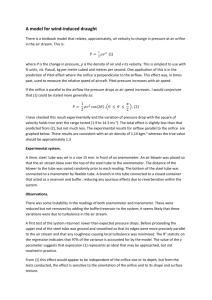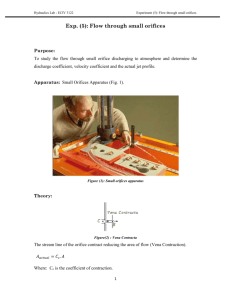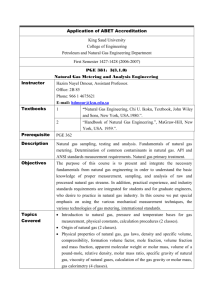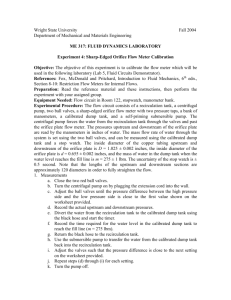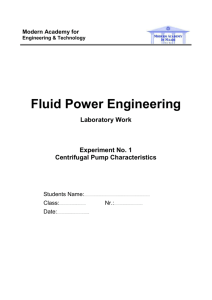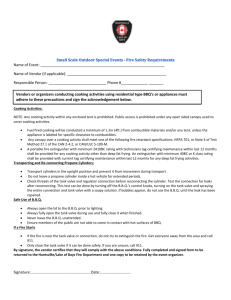ChE 253M Experiment No. 2 COMPRESSIBLE GAS FLOW THEORY
advertisement
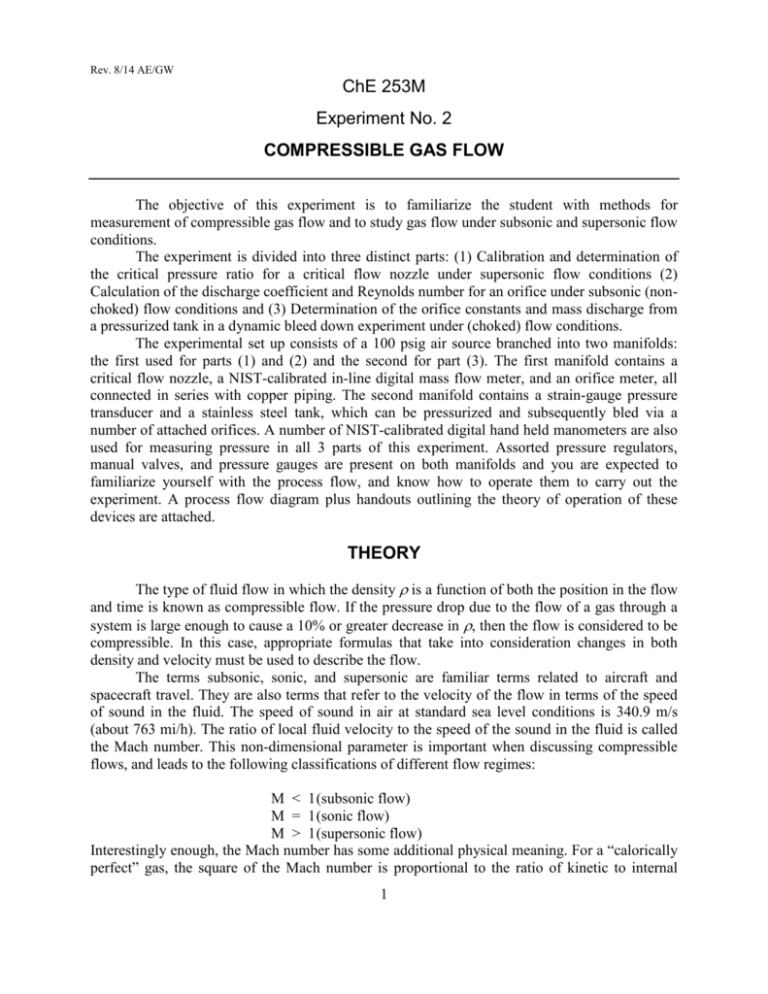
Rev. 8/14 AE/GW ChE 253M Experiment No. 2 COMPRESSIBLE GAS FLOW The objective of this experiment is to familiarize the student with methods for measurement of compressible gas flow and to study gas flow under subsonic and supersonic flow conditions. The experiment is divided into three distinct parts: (1) Calibration and determination of the critical pressure ratio for a critical flow nozzle under supersonic flow conditions (2) Calculation of the discharge coefficient and Reynolds number for an orifice under subsonic (nonchoked) flow conditions and (3) Determination of the orifice constants and mass discharge from a pressurized tank in a dynamic bleed down experiment under (choked) flow conditions. The experimental set up consists of a 100 psig air source branched into two manifolds: the first used for parts (1) and (2) and the second for part (3). The first manifold contains a critical flow nozzle, a NIST-calibrated in-line digital mass flow meter, and an orifice meter, all connected in series with copper piping. The second manifold contains a strain-gauge pressure transducer and a stainless steel tank, which can be pressurized and subsequently bled via a number of attached orifices. A number of NIST-calibrated digital hand held manometers are also used for measuring pressure in all 3 parts of this experiment. Assorted pressure regulators, manual valves, and pressure gauges are present on both manifolds and you are expected to familiarize yourself with the process flow, and know how to operate them to carry out the experiment. A process flow diagram plus handouts outlining the theory of operation of these devices are attached. THEORY The type of fluid flow in which the density ρ is a function of both the position in the flow and time is known as compressible flow. If the pressure drop due to the flow of a gas through a system is large enough to cause a 10% or greater decrease in ρ, then the flow is considered to be compressible. In this case, appropriate formulas that take into consideration changes in both density and velocity must be used to describe the flow. The terms subsonic, sonic, and supersonic are familiar terms related to aircraft and spacecraft travel. They are also terms that refer to the velocity of the flow in terms of the speed of sound in the fluid. The speed of sound in air at standard sea level conditions is 340.9 m/s (about 763 mi/h). The ratio of local fluid velocity to the speed of the sound in the fluid is called the Mach number. This non-dimensional parameter is important when discussing compressible flows, and leads to the following classifications of different flow regimes: M < 1 (subsonic flow) M = 1 (sonic flow) M > 1 (supersonic flow) Interestingly enough, the Mach number has some additional physical meaning. For a “calorically perfect” gas, the square of the Mach number is proportional to the ratio of kinetic to internal 1 energy. Therefore, it is a measure of the directed motion of the gas compared to the random thermal motion of the molecules. What is perceived as the sense of sound by the brain is in actuality, pressure fluctuations acting on the ear. These weak vibrations travel as pressure waves, alternate expansions and contractions, through the surrounding fluid. The velocity of propagation is the speed of sound and can be determined by applying the laws of conservation of mass and linear momentum across a pressure wave front traveling through a stationary fluid in a duct. The process inside the sound wave is assumed to be isentropic; there are no viscous forces acting on the fluid and no heat transfer to or from it. This assumption is valid since the wave front has an infinitesimal length and there is not enough time for heat transfer to occur. The flow is therefore considered to be reversible and adiabatic. Compressible Flow through Orifice and Venturi Meters Two types of devices are treated together: orifice and venturi meters. They are both obstruction meters, and based on the same fundamental principle. The device consists of an obstacle placed in the path of the flowing fluid, causing localized changes in velocity, and consequently, in pressure. At the point of maximum restriction, the velocity will be the maximum and the pressure minimum. A part of this pressure loss is recovered downstream. “1” “2” Flow Figure 1: Compressible Flow through an orifice The basic equation for calculating the pressure drop through an orifice or venturi is the Bernoulli equation, 1 (1) ρV 2 + ρgh = constant 2 If subscript “1” refers to the upstream conditions and subscript “2” to the downstream conditions at the point of pressure measurement, then assuming negligible change in temperature and no change in elevation (flow in a horizontal pipe) the Bernoulli equation simplifies to, p+ P1 + 1 1 ρ1V1 2 = P2 + ρ 2V2 2 2 2 (2) For an incompressible fluid such as a liquid, ρ can be assumed to be constant (for a gas ρ is not constant). If Q is the volumetric flow rate of the liquid, Q = A1V1 = A2V2, where A1 and A2 are 2 the cross-sectional areas at points “1” and “2” where the pressures are measured. Thus we can write: 2 1 Q 1 Q P1 − P2 = ρ1 1 − ρ1 1 2 A2 2 A1 2 (3) For a liquid, solving for Q1 the volumetric flow rate, Q1 = A2 2( P1 − P2 ) / ρ1 1 − ( A2 A1 ) 2 (4) However, a gas is compressible and so for gases an expansion factor (Y) must be added to the above equation to compensate for changes in density across the restriction. Also, to account for pressure losses in the device, a discharge coefficient Cd must also be introduced. Hence the final form of the equation governing the volumetric flow rate of a gas through an orifice is : Q1 = Cd Y A2 2( P1 − P2 ) ρ1 (1 − β 4 ) (5a) or Q1 = C Y A2 2( P1 − P2 ) ρ1 (5b) where β = d2 / d1 is the ratio of the orifice diameter to the pipe diameter and C ≡ Cd 1 − β 4 . Multiplying by the density upstream of the orifice, we obtain the mass flow rate, w, of the fluid at any point, w = ρ1 Q1 = C Y A2 2 g c ρ1 ( P1 − P2 ) (6) where the dimensional constant gc is added to account for the use of english units. For the flow of liquids, the expansion factor, Y, is unity but for gases can be calculated from 1 − r (γ −1) γ 2γ γ = Y r − 1 γ 1 − r 1 − β 4 4 2γ 1 − β r (7) where r = P2 / P1 and γ = cp / cv is the specific heat ratio, equal to γ = 1.4 for air. For values of β less than 0.25, β 4 aproaches zero and the last bracketed term in the above equation approaches 1 so that the equation simplifies to γ 1 − r (γ −1) γ Y = r 2 γ γ 1 − 1 − r 3 (8) Values of Y as a function of r, β and γ can be calculated either directly from equations 7 or 8 or can be read from a graph that readily displays computed values of Y as a function of these parameters (see appendix). Finally, substituting equation 8 into the mass flow rate equation 6 and simplifying using the ideal gas law yields the general equation for subsonic (non-choked) flow of an ideal gas through an orifice w = C P1 A2 2γc M RT1 2γ P γ P2 − 2 γ − 1 P1 P1 ( γ +1 ) γ (9) Critical Flow Nozzle – Choked Flow Consider the case where a compressible fluid is expanded from a given pressure “1” to a lower downstream pressure “2” in a carefully-machined nozzle as was the case in Figure 1. As the downstream pressure, or back pressure, is lowered, the mass flow rate and the fluid velocity increase until the velocity in the throat of the nozzle becomes sonic. The value of r = P2 / P1 for which the acoustic velocity is just obtained is called the critical pressure ratio rc and depends only on γ (ratio of specific heat capacities) and β (ratio of nozzle to pipe diameters). For β ≤ 0.2 this is given by 2 rc = γ + 1 γ γ −1 = 0.528 for air (γ =1.4) (10) As long as the flow in the throat is sonic, the mass flow rate through the nozzle is constant for a given value of upstream pressure, and the flow is said to be choked. Any further lowering of the downstream pressure does not increase the throat velocity above sonic. However, if the downstream pressure is raised above this critical value, the velocity at the throat goes subsonic and choked flow conditions no longer exist (Figure 2). Mass Flow Air Velocity Sonic Velocity 1127 ft/s @ 68 ºF P1 = Constant γ γ −1 2 rc = γ +1 = 0.528 for air 1 P2 / P1 0 Figure 2: For a fixed inlet pressure P1, the air velocity and mass flow rate are limited (choked) below the critical pressure ratio. 4 During choked or critical flow conditions, the flow rate can be increased only by increasing the upstream pressure. When the pressure ratio r reaches the critical value rc of equation 10, then the mass flow rate for choked flow in equation 9 reduces to: γ γM w = CAP c RT1 2 γ + 1 ( γ +1) ( γ −1) . (11) Since C, A, gc, γ, M, R are constant for a given nozzle and gas, they can be combined to result the following simplified relation: γ γM w = KP , K = CA c T R 2 γ +1 (γ +1) /(γ −1) ) 1/ 2 (12) It turns out that K (and hence C) is a weak function of P (a plot of K versus P for the critical flow nozzle used in this experiment is attached in the appendix). Therefore, at choked flow the only measurements required to determine the flow rate through the critical flow nozzle are the upstream pressure and temperature. Finally, note than when a downstream diffuser (divergent) recovery section is added to the flow nozzle (better known as critical flow venturi nozzle), the value for the critical pressure ratio rc is no longer the theoretical value given in equation 10, but ranges from 0.80 to 0.95 depending on the design. (Note: the flow nozzle in this experiment does have such a diffuser recovery section). List of Variables and Constants Q1 = upstream volumetric flow rate, ft³/s w = mass flow rate at any point, lbm/s Cd = coefficient of discharge, dimensionless C = orifice flow coefficient, dimensionless Y = expansion factor, dimensionless A1 = cross-sectional area of the pipe, ft² A2 = cross-sectional area of the orifice hole, ft² d1 = diameter of the pipe, ft d2 = diameter of the orifice hole, ft β = ratio of orifice hole diameter to pipe diameter, dimensionless V1 = upstream fluid velocity, ft/s V2 = fluid velocity through the orifice hole, ft/s P1 = fluid upstream absolute pressure, lbf/ft2 P2 = fluid downstream absolute pressure, lbf/ft2 ρ1 = upstream fluid density, lbm/ft³ R = Universal Gas constant, 1545 ft lbf / lbmole °R gc = dimensional constant, 32.2 lbm ft/sec2 lbf 5 Dynamic Pressure Bleeddown Rate Measurement An important application of choked flow is in calculating accidental release flow rates from pressurized gas systems. Every pressure tank in a chemical plant is connected to a flare system through a pressure relief valve. This is to ensure that if a pressure vessel becomes overpressurized, the tank can relieve itself without rupturing. In most cases the flow from the tank passes through a restriction where the flow is sonic and it is the diameter of the restriction which determines how fast gas can escape. Gas flow is sonic if the upstream absolute pressure is approximately twice the downstream pressure (approx. 28 psia when released to the atmosphere). The experimental tank, rated at 1,800 psig, has an internal volume of 10.3 L. The air is released through orifices having diameters of 0.030, 0.040, and 0.055 inches plus an orifice of unknown diameter to be determined experimentally. The rate of pressure fall-off through these three orifices is measured with a pressure transducer that is connected to a computer-based data acquisition system. As we have seen earlier, for a critical flow orifice γ γM w = CAP c RT1 2 γ + 1 ( γ +1) ( γ −1) (11) We can simplify this equation in a manner similar to what we did in equation 12. If air is discharged at constant upstream temperature T1 then the equation can be simplified to w= dm = Kd 2 P dt (13) so that the mass flow rate is only a function of the pressure P and orifice diameter d, and all other variables are included in the orifice constant K. Since air is an ideal gas, PV = nRT = m RT M so that m = PVM RT (14) and differentiation yields dm VM dP . = dt RT dt Substituting back into (13), VM dP = Kd 2 P RT dt dP Kd 2 RT = dt P VM P t dP Kd 2 RT = ∫ P t∫ VM dt P0 0 6 (15) ln P = Kd 2 RT t + constant VM ln P = K ' d 2t + constant (16) In this part of the experiment, you will use Equation 16 to determine K' based on your experimental data for the three orifices provided and then use this value to determine the diameter of an unknown orifice. Finally, if we assume that our process is adiabatic and frictionless, then the discharge of the gas through the orifice is an isentropic expansion of an ideal gas for which Pρ −γ = constant (17) For a tank with constant volume, the density ρ is proportional to the mass of the gas inside the tank and equation 17 can be re-arranged to yield a simple relation between the pressure in the tank and the mass fraction f = m m0 of fluid remaining, P = P0 f γ (18) 7 Pressure And Flow Measuring Devices Used in this Experiment Bourdon Gauge This very common gauge operates on the principle that the deflection or deformation in a spiral metal tube can be related to the balance of pressure and elastic forces. The Bourdon tube is initially coiled in a "C" shaped arc. The tube is sealed at one end and open to the pressure to be measured at the other. As the pressure increases, the tube deforms, and the motion is transmitted to a dial indicator by means of a mechanical linkage. Note that in this experiment, the bourdon gauge is used only as a visual indicator – the NIST-calibrated Digital Handheld Manometer described below will be used for recording pressure data to be used in your calculations. Schaevitz Strain Gauge Transducer Whereas the bourdon gauge discussed above produces a direct measurement of the applied pressure via its mechanical linkage and dial indicator, the Schaevitz strain gauge outputs a voltage signal that is proportional to the applied pressure. This is because the Schaevitz strain gauge is a transducer. Broadly defined, a transducer is a device, usually electrical, electronic, or electro-mechanical, that senses or converts a signal from one form to another. In our case, the strain gauge converts a physical signal (pressure) into an analog signal (voltage). The most common type of strain gauge consists of an insulating flexible backing which supports a metallic foil pattern. As pressure is applied, the foil is deformed, causing its electrical resistance to change. This resistance change, usually measured using a Wheatstone bridge, is related to the applied strain. Another popular class of strain gauge transducers employs a piezoelectric-type element. Application of pressure causes it to deform and generate a small potential that is proportional to the applied pressure. Differential Manometer This instrument consists of a simple U-tube about half full of a liquid (in this case, water) of known density. The two ends of the tube can be connected to the two pressure sources. The height difference in the liquid column is then proportional to the pressure differential. Digital Handheld Manometer (NIST Calibrated) Just like the Schaevitz gauge, this is also a strain gauge transducer but here the strain element is not a metallic foil but a semiconductor, usually a piece of crystal silicon. Application of pressure on semiconductor materials such as silicon and germanium causes a proportional change in the resistance of these materials, a phenomenon known as the piezoresistive effect. Digital Mass Flow Meter (NIST Calibrated) The stream of gas entering the Mass Flow transducer is split by shunting a small portion of the flow through a capillary stainless steel sensor tube. The remainder of the gas flows through the primary flow conduit. According to principles of fluid dynamics the flow rates of a gas in the two laminar flow conduits are proportional to one another. Heat flux is introduced at two sections of the sensor tube by means of precision wound heater sensor coils. As the gas flows inside the sensor tube, heat is carried by the gas stream from the upstream coil to the downstream coil windings. The resultant temperature-dependent resistance differential is detected by the electronic control circuit and the measured gradient at the sensor windings is linearly proportional to the mass flow rate taking place. 8 PROCEDURE In addition to the various gauges listed above, the manifold assembly for parts (1) and (2) includes a main ball valve that supplies air pressure and three gate valves. For part (1), using Manifold A, these valves regulate the pressures in the various parts of the system as follows : • • • Valve 1A (Pressure Regulator) is located upstream of the critical flow nozzle and regulates the pressure (P1) upstream to the nozzle. Under choked flow conditions, the mass flow rate through the system is a function of this pressure and temperature only. Valve 2A is located downstream of of the critical flow nozzle next to a turbine flow meter that is not used in this experiment. It regulates the back pressure (P2) of the nozzle. To ensure choked flow, P2 must be kept below its critical value. Valve 3A is located downstream of a rotameter not used in this experiment. This valve should stay open throughout the experiment. 1. Determination Of The Critical Pressure Ratio For Choked Flow And Calibration Of Critical Flow Nozzle (CFN): 1) Record the atmospheric temperature and pressure. 2) Set P1 at P1-1 (see parameters) psig by adjusting valve 1A (the pressure regulator). Open valves 2A and 3A completely. 3) Allow 1-2 minutes for the digital mass flow meter to stabilize and record this QDFM value . Also record the temperature (T1) upstream to the nozzle. 4) Increase the backpressure (P2) to 5 psig by setting valve 2A appropriately and record the new flowrate (again, allow enough time for the reading to stablize). 5) Continue to raise the backpressure (P2) in increments of 5 psig and note the point at which the digital mass flow meter reading begins to change. The corresponding value of P2 is the critical backpressure for the given value of P1. When P2 is greater than this critical value, the flow through the throat is no longer sonic and decreases as P2 increases. 6) Determine the critical backpressure for the CFN at an upstream pressure (P1) of P1-2, P1-3 and P1-4 and open valve 1A when you are finished. 2. Discharge Coefficient For The Orifice Meter Install the orifice specified in Parameters. Open valves 2A and 3A completely. Make sure the manometer is about half-full of water and open the turn valves on the sides of the orifice to allow the pressure to reach the differential manometer. Set P1 (by adjusting valve 1A) such that the manometer DP is DP-1 4 inches H2O. Record this P1, T1 and flow rate QDFM for this setting. Repeat for DP = DP-2 and DP-3 8 and 10 inches H2O. When you are finished, make sure you 9 close the turn valves on the sides of the orifice and the main ball valve that supplies air pressure to the manifold. 3. Dynamic Pressure Bleeddown Rate Measurement NOTE: You can save your data on a USB memory stick or in your UT webspace account The manifold assembly B for this part consists of the main valve that supplies air pressure, plus: • Valve 1B is a pressure regulator that controls the air pressure into the system • Valve 2B is a manual ball valve that controls the air pressure to the digital manometer • Valve 3B is a manual ball valve upstream of the Schaevitz Strain Gauge transducer • Valve 4B is a manual ball valve downstream of Schaevitz Strain Gauge transducer • Valve 5B is a manual gate valve upstream of the tank. Leave this valve open at all times. (i) Calibration of the Schaevitz Strain Gauge transducer First you need to calibrate the Schaevitz Strain Gauge transducer (output in millivolts) against the NIST-calibrated handheld digital manometer (output in psig). 1. Make sure the 10V DC power supply located behind the computer (used to power the Schaevitz Strain Gauge transducer) is switched on and then start the Dell computer. Login as “Student” and double click the icon on the desktop labeled “Tank Bleeddown.vi”. This is a LabView based program written specifically to control the data acquisition process, and continuously displays the voltage output from the Schaevitz Strain Gauge transducer. 2. Verify that Valves 2B and 3B are open and Valve 4B is closed (NO air going to the tank). Open the main manual ball valve that supplies air pressure to the manifold, and adjust the pressure regulator (Valve 1) until the pressure reading on the NIST-calibrated handheld digital manometer is ~20 psig. Read the corresponding voltage output from the Schaevitz Strain Gauge transducer via the LabView program on the computer. 3. Repeat the process in steps of 10 psig until you reach a final pressure of 90 psig. You now have 8 points of Pressure vs. mV to obtain a calibration curve. (ii) Bleeddown Experiment 4. You are now ready to fill the tank with air. First make sure all the orifices attached to the tank are closed and close valve 2B (digital manometer off-line). Increase the line pressure to ~95 psig, and open valve 4B to fill the tank. You should hear the air filling the tank. When it stops, close valve 3 so that air does not refill the tank while it is discharging. 5. On the computer you should see the voltage reading on the graph display increase as the tank fills up and then plateaus when the pressure has stabilized. You may also change the rate at which data are collected via the “Data Collection Rate” control. Typically, you should select a slow data collection rate for small orifices and a fast data collection rate for the larger orifices. Once you have selected a data collection rate, click the “Save Data” button and enter 10 a filename for the bleeddown trial. The voltage data is saved in an EXCEL spreadsheet file in the directory C:\DATA\. 6. The transducer voltage should show up immediately and begin plotting on the screen. Keep in mind that the orifice bleeddown coefficient describes the pressure over time only while the orifice is open. Data collected while the orifice is closed is useless for such an analysis. Therefore you should disregard data that is collected after the orifice is closed. 7. Wait for a few seconds until you save a baseline pressure reading from the tank and then open one of the orifice valves (you will be doing 3 runs - it doesn’t matter which one you do first). Then, allow the pressure to drop to approximately 35 psig by monitoring the pressure reading on the small gauge at the side of the tank. When the pressure has reached close to 30 psig, close the orifice valve and on the computer click the button labeled “Writing to data file – click again to stop writing.” The program resets and is now ready for a new acquisition – you do not have to press the red stop button on the software after each run, only at very end of the experiment. 8. Repeat the above process for the two other orifices by simply opening valve 3B to fill up the tank again and close it after the pressure inside the tank has stabilized. Also, do one trial where the 0.030” and 0.040” orifices are simultaneously opened and a run for the orifice of unknown diameter which you will determine in this experiment. You should end up with a total of 5 bleeddown runs. Data Analysis Note: CFN= Critical Flow Nozzle DFM=Digital Mass Flow Meter 1. CFN: Estimate within ± 2 psi the value of P2 for which sonic flow occurs at the throat (describe clearly how you reached this value; plotting your data similar to Figure 1 might help), and tabulate the critical pressure ratios rc = P2 / P1 to calculate an overall average. Compare your result with the CFN manufacturer’s claim that “The diffuser provides efficient recovery allowing critical flow to be maintained at inlet to exit pressure ratios (Pl / P2) as low as 1.2”. What is the relation between psig and psi? For a given value of P1, which is the faster way you propose to determine rc? 2. Determine the calibration equation of WDFM (NIST-Calibrated Standard) vs. WCFN. A manufacturer’s performance curve is attached in the appendix for the CFN. Compute 95% confidence limits, and show the confidence intervals on the graph. Discuss the accuracy/precision of the CFN compared to the DFM standard. 3. Orifice: Calculate the discharge coefficient and the Reynolds number of the flow for each value of DP. Compare these values with the values obtained from published data in Perry’s Handbook (see appendix for a copy of this graph). How do you calculate the value of P1 in your calculation of discharge coefficient? 4. Tank Bleeddown: Use JMP to produce the following 5 graphs (EACH with confidence limits) showing slope, intercept, and confidence limits are expected. In your appendix, show 11 sample calculations for the slope, intercept, and confidence limits for any ONE of these 5 runs: • Ln (P) vs. t for 0.030” orifice • Ln (P) vs. t for 0.040” orifice • Ln (P) vs. t for 0.055” orifice • Ln (P) vs. t for 0.030” and 0.040” orifices opened simultaneously • Ln (P) vs. t for the unknown orifice • Finally: For your raw data, PLEASE do not include several pages of the raw P vs. t data from the computer. Instead show all your P vs. t data for all orifices on a single excel P vs. t plot and clearly indicate which curve corresponds to which orifice. 5. Make a single plot for all 3 orifices [0.030”, 0.040”, and 0.055”] for the exponential drop of mass of air remaining in the tank m versus time. Normalize these graphs such that at t=0, P0 = 90 psig and Pfinal= 30 psig. Calculate the absolute (in lbs) and relative (% of initial) amount of gas escaped from each orifice during this time. (Hint: Use ideal gas law for m0 and Eq.18 for the mass fraction remaining) 6. Determine the average experimental K’ values from the four bleed-down trials (the three individual orifices plus the combination) including its confidence interval. 7. Calculate the diameter of the unknown orifice and the error on this calculation. 8. Compare the slope of the simultaneous discharge of the 0.030” and 0.040” orifices to (i) the sum of the slopes for the 0.030” and 0.040” individual orifice discharges and (ii) the sum of the slopes for the 0.030” and 0.055” individual orifice discharges. Does the tank bleed faster with only the 0.055” orifice open or when the 0.030” + 0.040” combination is open? Briefly explain your observation. 9. Discuss the importance of the time axes in the bleed down experiments. What is the consequence of making an error of several seconds in coordination data acquistition and valve opening? What is you start data collection late? What if you start early? SAMPLE CALCULATIONS GUIDE Note : Convert all pressures and temperatures to their absolute values Orifice Plate (sharp edged) ID = Pipe ID = 0.189 inches 0.75 inches 1) Calibration of CFN : Aim: WDFM vs. WCFN • WCFN = K P T obtained from P1, T1 and graph in appendix; 12 • WDFM = QDFM ⋅ ρ DFM and since the DTM is essentially open to atmospheric pressure, r DFM = r atm = Patm M air RTatm 2) Orifice Meter: Aim: Find the discharge coefficient Cd in Q = C d A2Y where, A2 Y DP' β = = = = 2 g c (DP ' ) ρ1 ' (1 − β 4 ) (= QDFM ) Area of orifice (refer to data) expansion factor (Eq. 8 or from graph attached in appendix) from reading (Dh) d2/d1 (refer to data) Now, P2' = Patm as the orifice is essentially open to the atmosphere, and P1' = Patm + DP' ρ1' = P1' Maiρ P1' M aiρ ( Patm + ∆P' )M aiρ ≈ = RT1' RT atm RT atm The Reynolds number is Re = vor Dor r atm mair ; QDFM = vor ⋅ Aor APPENDIX 13 Manifold B Main Valve Manifold A Main Valve Valve 1B P2 (Bourdon Gauge) P1 (Bourdon Gauge) Valve 2A CFN Digital Manometer Valve 1A Schaevitz Press. Transducer Valve 3B Valve 2B Digital Manometer Diff. Manometer Orifice Valve 4B Valve 5B Digital Manometer Gauge Orifice Assembly Tank Schematic Of Experimental Setup 14 Digital Flow Meter Valve 3A 15 γ 16
